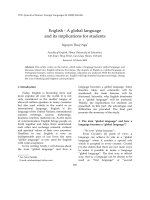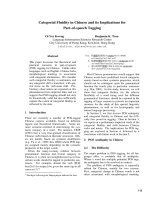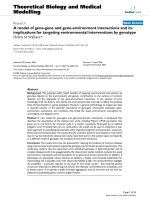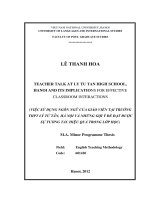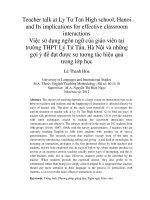Metonymy and its implications for teaching vocabulary
Bạn đang xem bản rút gọn của tài liệu. Xem và tải ngay bản đầy đủ của tài liệu tại đây (76.92 KB, 12 trang )
Full name : Tran Thi Thu Trang (1985)
Class: 18C
College of Foreign Languages - VNU
Metonymy and its implications
for teaching vocabulary
I. Abstract
Vocabulary, much more than grammar, is the key to a second language
learner understanding what she/he hears and reads in school; and to
communicating successfully with other people.
Among many issues related to vocabulary, linguists and teachers of
English nowadays have paid more attention to metonymy, one aspect of
transference of meaning. It is also considered to be helpful for learners in the
process of building up a large store of words and using language creatively. I
have been a teacher of English for just one year; In some readings lessons I
have taught, I found that my students had difficulties comprehending words
which should be understood in their metonymic sense. For such reason, I
decide to study metonymy and try to find ways for teaching this effectively by
consulting ideas presented in research on this subject of former MA students
because I have not got much experience in teaching. In this paper, I’d like to
review the matter of metonymy and present its implications for teaching
vocabulary.
II. What is metonymy?
According to Nguyen Hoa, metonymy can be defined as the
substitution of one word for another with which it is associated. Metonymy
works by contiguity rather than similarity.
According to standard tradition, metonymy is defined as a “figure in
which one word is substituted for another on the basis of some material,
causal, or conceptual relation. Some substitutions include palce-forinstitution, thing-for-perception, 0r object-for-possessor, or part-for-whole, or
place-for-event.
For Nunberg (1978, 1979), metonymy is a case of “deferred reference”,
in which a speaker uses a description of A and succeeds in referring to B.
Nunberg also regards metonymic uses as a kind of “local” word uses that are
perceived as rational against a system of beliefs that is available only to a subsection of the community.
According to Galperin I.R, metonymy is based on a different type of
relation between the dictionary and contextual meanings, a relation based not
on identification, but on some kind of association connecting the two concepts
which these meanings represent.
From Wikipedia, the free encyclopedia. Metonymy is defined from two
different perspectives. In rhetoric, metonymy is the substitution of one word
for another word with which it is associated. In cognitive linguistics,
metonymy refers to the use of a single characteristic to identify a more
complex entity and is one of the basis characteristics of cognition. It is
common for people to take one well-understood or easy-to-perceive aspect of
something and use that aspect to stand either for the thing as a whole or for
some other aspect or part of it. Sometimes, metonymy is seen as a specific
kind of symbolism by which the most essential component of an object is
abstracted to represent it. For example, if a person is well-known for his red
hair, this feature “red hair” can lend itself to referring to the person who has
red hair.
That red hair is getting angry with his wife.
According to Kukharenko V.A, metonymy also becomes instrumental
in enriching the vocabulary of the language and it is based on contiguity
(nearness) or objects of phenomena.
So, according to those definitions, metonymy can be understood as a
transference of meaning based on a logical or physical connection between
things. In metonymy, a thing is described by its action, its function or by some
significant features. It is one of the means of forming the new meanings of
words in the language.
Many examples of metonymy are highly conventionalized and easy to
interpret. However, many others depend on an ability to infer what the
speaker has in mind. The metonymy in the strings are too quite is easier to
understand if you are familiar with orchestral music. Or we can say that we
have to rely on context, background knowledge and inference to understand
metonymic expressions.
III. Types of metonymy
Metonymy is classified into 3 types according to Alexey in his article
“The metonymic way of an attributive description of the subject: cultural
aspect”
1. Direct, or primary, metonymy
Direct metonymy is the direct transference of the meaning to the object
on the basis of association with the subject itself. For example:
“We could hear the cheery clatter of our knives, the laughing voices…”
(J.K. Jerome)
In this case, the participle “laughing” that characterizes the subject expressed
in this sentence by the pronoun “we” is used with the noun “voices”, although
no voice can laugh by itself; it is the property of human being. The
description is transferred from the subject itself to its part, so it is obvious that
this sentence is an example of primary metonymy.
An interesting example of primary metonymy is its usage in such a
cultural phenomenon as wishes. By saying to each other “Happy New Year!”
or “Merry Christmas!”, people in reality explicate the thought “ I wish you to
be happy in the new year” or “I wish you to be merry on Christmas”. The
usage of direct metonymy is quite obvious in cases like these.
2. Indirect, or secondary, metonymy
This type of metonymy is the double transference of the meaning to
another object on the basis of association with the manner of action of the
subject mediated by the subject itself. For example:
“Poirot waved an impatient hand.” (A. Christie)
Here is the analogous transference of the meaning from the manner os
an action of the subject (waved impatiently) to the object (hand), mediated by
the subject (Poirot), because it is not the hand that is impatient, but Poirot
himself waves impatiently.
3. Partial metonymy
Differently from the first two types, this type of metonymy employs the
use of an attribute which acquires a certain degree of associativeness with the
subject. For example:
“Tyger! Tyger! Burning bright
In the forests of the night
What immortal hand or eye
Could frame thy fearful symmertry?” (W.Blake)
In this fragment, the usage of metonymy can be observed in the nouns
“hand” and “eye”. The attribute “immortal” characterizing the subject of this
transference (obviously “God”) does not bear in itself the pronounced
metonymic complexion, but has only a shade of the associative transference.
As a matter of fact, the attribute “immortal” only adds to nominative
metonymy in the words “hand” and “eye”, and therefore can not by itself be
regarded as complete and self-sufficient metonymy
IV. Cases of metonymy
The relationship between words are based simply on a close connection
in everyday experience. That close connection can be based on a container –
contents relation (bottle-coke; can-juice), a whole-part relation (car-wheels;
house – roof) or a representative – symbol relationship (King – crown; the
President – the White House). We will look at some cases of metonymy as
follows.
1. Name of container to refer to the thing contained.
Examples:
The kettle is boiling. (1)
He drank the whole cup. (2)
Obviously, the kettle can not boil as well as the man can not swallow the cup.
However, we all understand that the water in the kettle is boiling and the man
drank some coffee or some tea in the cup, not the cup itself. In other words,
“kettle” and “cup” in this examples are used to refer to other things, which are
contained in those kinds of containers.
The following table shows how these words carry different meanings in
original use and metonymic sense:
1
kettle
Original use
Metonymic use
a container with a lid, handle Water boiled in the
and a spout, used for boiling kettle
2
cup
water
Container shaped like a bowl, Water/coffee/tea/etc.
usually with a handle, used for in the cup
drinking tea, coffee, etc.
2. Names of parts of human body used as symbols.
Human beings in the process of using language firstly got to know
about their own body and gave names to its parts. Later, when they discover
the world outside , they compared the surrounding objects with their own
body. Hence the name of parts of human body are transferred to denote many
other things or parts of things in the real world. In that case, we have
“metaphor”. However, sometimes names of parts of human body are used to
be the symbol for characteristics of a kind of person.
Examples:
The boy has a very clever head.
This is an example of indirect metonymy. Head is normally considered as the
most important part of the body which controls the operation of the whole
body and it contains the brain which has direct relation to a person’s
intelligence. So if that person is very clever, the word “head” is employed to
symbol that characteristic.
3. The concrete to refer to the abstract
Concrete is defined as what you can see or feel. Abstract, however, is
something existing in thought or as an idea but not having a physical reality. It
is normally difficult to express something abstract, so people tend to use the
concrete to visualize the abstract, to give it “a physical reality”. Here is an
example: “First we must roll up our sleeves.”. Originally, “roll up the sleeves”
denotes an action which is regularly done when people want to start doing
something by making the sleeves in the shape of a tube. However, in this
example, the phrase is understood as making a move of trying.
4. Materials to refer to the things made of the materials
In many cases, people find it is not easy to name something and they
are not sure about what is the most appropriate way to call it. Then, the name
of materials are taken to name their products.
Examples:
Can you give me a rubber, please?
rubber
Original use
Metonymic sense
Material got from juice of a A rubber (eraser) which
tropical plant that can be is used for removing
In this
stretched and does not allow pencil marks from paper.
liquid to pass through it
situation, a rubber is made of rubber. The metonymic sense of the word really
works effectively because it not only helps to name the object but also is a
useful way to distinguish them from other objects.
5. Name of the author to refer to his works
Author and his works share a very close relation and his name can be
normally not be separated from his works. That seems to be the reasons why
authors’ names are transferred to denote their work.
Example:
I love reading Shakespeare before going to bed.
Original use
Metonymic sense
Shakespeare Name of an English playwright
Shakespeare’s works
The transfer of names of inventors or authors as “volt”, “ampere”, “watt” are
also found.
6. Part to refer to a whole and vice versa
The relation between a part and a whole is always easy to be seen, so
that metonymy can bas eon this relation to transfer the meaning of words.
Firstly, we look at some examples in which the words denoting the
parts can substitute for the words of the wholes.
Examples:
We live in the same roof.
Can you see a sail on the horizon?
1
roof
2
sail
Original use
Metonymic sense
The structure that covers or House/building
forms the top of a building
A part of the boat which the Boat
wind blows against to make
the boat travel through the
water
The “roof” and the “sail” are the two distinguishing features of a house and a
(sailing) boat. As a type of extension, metonymy use those parts to refer to the
whole objects.
However, sometimes metonymy is also the use of the whole object to
refer to a part of the object.
Examples:
Don’t sit down! The chair has been broken. There are just three legs
now.
She is wearing a fox.
1
Chair
Original use
Metonymic sense
A piece of furniture for A leg of the chair
one person to sit on, with
a back, a seat and four
2
fox
legs.
A wild animal of the dog The skin and fur
family
with
reddish- of the fox used to
brown fur, a pointed face make coats, etc.
and a thick heavy tail.
7. Symbol to refer to representative
The convention of using capital cities to represent countries or their
governments is another example of metonymy. Consider the following
example:
Hanoi highly appreciates all what have done by Washington in
order to build up a good relationship between the two countries.
1
2
Hanoi
Washington
Original use
Name of Vietnam’s capital
Metonymic use
Vietnamese
Name of United States of
government
American
America’s capital
government
8. Others
A part from those types of metonymical relations, other types can be
found in English including: spatial, causal, functional and transfer of
geographical names.
Examples:
He was elected chair of the city council. (spatial)
Fear of failure was bred into him at an early age. (causal)
He penned a letter to the local paper. (functional)
She has bought a new pair of morocco shoes. (transfer)
1
The chair
Original use
Metonymic sense
The position of being in The person who
charge of a meeting or a holds the position of
committee
being in charge of a
meeting
2
fear
or
a
committee
The bad feeling that
danger
you have when you
3
4
Pen
morocco
An
instrument
used
are in danger
for To pen: to write
writing with ink
something
Name of a country
A sport team
From what we have mentioned, we find that metonymy is a powerful way to
transfer meaning of a word to refer to another referent. By simply using the
contiguity between notions basing on metonymical relations, English people
have changed their language.
V. Implications for English Vocabulary Teaching
In Vietnamese everyday life, metonymy is used in many different
contexts and becomes very familiar with people without any questions about
the existences of it. Vietnamese people rarely question the source of
underlined words in the following examples:
Đi uống vài chén đi!
“Bàn tay ta làm nên tất cả
Có sức người sỏi đá cũng thành cơm.”
Metonymy is not just a figure of speech, but reflects an important part
of the way people ordinarily conceptualize themselves, events and the
everyday world. Metonymy also helps structure various aspects of inference
generation in discourse, as well as people’s understanding and use of
contextual expression, indirect speech acts, common gestures, and colloquial
tautologies. Because of that, in the process of teaching English, especially
English vocabulary, teaching metonymy is essential and important. Learning
about metonymy will help students enrich their vocabulary so as to make their
communication successful and effective.
Some linguists say that teachers can illustrate the cognitive nature of
metonymy, and guide students to explore the metonymic motivation of a
word. This will help students to make clear the internal relationship among
different meanings of one word, make reasonable cognitive reasoning, and
gradually grasp the language rules. In this way their learning efficiency will
be greatly improved and their vocabulary amount will be expanded a lot.
However, I prefer the idea that teachers help students find the link between
the word’s original use and metonymic sense, which means providing them
some relations which can help students to understand metonymic sense
without the help of their teacher, and to create their own metonymy.
Making a comparison between the two languages seems one of the best
ways to realize the matter and avoid any mistakes in using language and
translation. This task should be guided carefully in the classroom then teacher
asks students to do it at home after every lesson.
In addition, teachers should make clear any points of the similarities
and differences between metonymy in English and that in Vietnamese for
students. For students from pre-intermediate level of English they can draw
conclusion themselves with their language, so let them give examples of
metonymy and then contrast the two languages. By this way, teachers can
help students not only be able to interpret the meaning themselves but also
build up their skills of reasoning in using language and develop their
communicative competence.
Beside its usefulness in learning vocabulary, metonymy is also helpful
in translation. Teachers should tell students to avoid word-by-word translation
and should be aware of the similarities and differences between the use of
metonymy in English and Vietnamese.
In short, we deeply understand that the world exists as a systematic unit in
which every element has relations with each other, so that language is capable
of denoting different things when using the same language element. The
transference of meaning of a word, therefore, is necessary in the process of
using language creatively and effectively. Metonymy, together with metaphor
and other means of transference of meaning, is helping to enrich vocabulary
of every language.
References
1. Kearns, K. (2000). Semantics. New York: Palgrave Macmillan.
2. Saeed, J. I. (2005). Semantics. Oxford, UK: Blackwell.
3. Lyons, J. (1996). Linguistic Semantics - An introduction. Cambridge: CUP.
4. Hurford, I.R., and Heasley, B. (2003). Semantics - A course book. Vietnam:
First New.
5. Nguyen Hoa. (2004). Understanding English Semantics. Hanoi: VNU
Publishing House.
6. Vo Dai Quang. (2005). Semantics. Hanoi: Publishing House of Culture and
Information.
7. Pham, Thi Hoai Thu. (2007) Metonymy as the transference of meaning: a
contrastive analysis of English and Vietnamese. Hanoi
